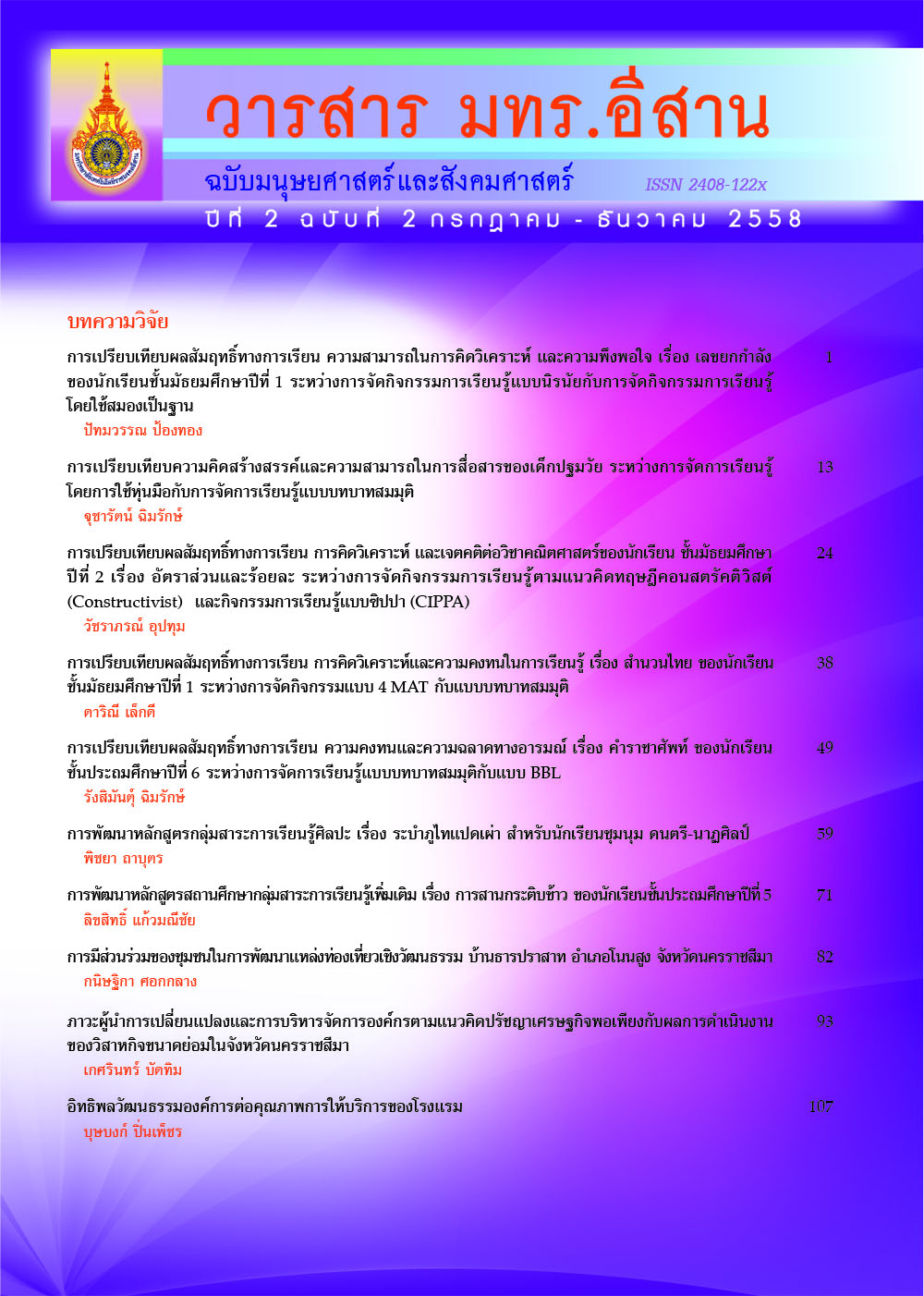Community’ s Participation of Tharnprasarth Nonsung Nakhonrathasima
Main Article Content
Abstract
The purpose of this research was study the participation of communities in the dereloping of Tourist Attraction Culture at Ban Than Pra Sart, Known Soong, Nakhon Ratchasima. By using the Questionnaire with the population around Ban Than Prasart ared amount 3 villages comprises, Moo 7, Moo 8, and Moo 17 total are 332 people. Derived form the principles of probability sampling using a stratified random sampling method and analyzed by frequency percentage mean and standard deviation. Testing hypotheses using inferential statistics (t-test and f-test = ANOVA).
The results showed that the most are women between 51- 60 years of age, marital status. The highest education is below high school. Manic subsistence farming Manitoba have a monthly income of less than 5,000 baht, mostly locals by birth that living in these communitie more than 45 years and live in Moo 7. The results of the study showed respondents’ participation in community decision-making in selecting community leaders Ban Than Pra Sart and practice about cleaning of waste disposal in the community Ban Than Prasart. The beneficiaries are beneficiaries of the tour Ban Than Pra Sart and the monitoring and evaluation to meet and talk with local people about the effects that occur in Ban Than Pra Sart.
The experimental results has found the respondents with the different about sex, age, education, marriage status, domicile, career, revenue and period of time that live in these communities paeticipate of communities for development the tourist attraction “Ban Than Pra Sart. It is different significantly of statistististical at level 0.05 and 0.01.
Article Details
บทความที่ได้รับการตีพิมพ์เป็นลิขสิทธิ์ของมหาวิทยาลัยเทคโนโลยีราชมงคลอีสาน
ข้อความที่ปรากฏในบทความแต่ละเรื่องในวารสารวิชาการเล่มนี้เป็นความคิดเห็นส่วนตัวของผู้เขียนแต่ละท่านไม่เกี่ยวข้องกับมหาวิทยาลัยเทคโนโลยีราชมงคลอีสานและคณาจารย์ท่านอื่นๆในมหาวิทยาลัยฯ แต่อย่างใด ความรับผิดชอบองค์ประกอบทั้งหมดของบทความแต่ละเรื่องเป็นของผู้เขียนแต่ละท่าน หากมีความผิดพลาดใดๆ ผู้เขียนแต่ละท่านจะรับผิดชอบบทความของตนเองแต่ผู้เดียว
References
กาญจนา เพชรประยูร. (2545). การมีส่วนร่วมของประฮาชนต่อการพัฒนาที่ยั่งยืน : กรณีศึกษาตลาดน้ำ
บางประมุง ตำบลบางประมุง อำเภอโกรกพระ จังหวัดนครสวรรค์. มหาวิทยาลัยราชภัฏนครสวรรค์.
กุลจิรา เสาวลักษณ์จินดา. (2555). การมีส่วนร่วมของประชาชนต่อการจัดการแหล่งท่องเที่ยวชุมชนและศึกษาระดับการมีส่วนร่วมของประชาชนในการจัดการแหล่งท่องเที่ยวของชุมชน ในอำเภออินทร์บุรี จังหวัดสิงห์บุรี. ค้นคว้าอิสระ ปริญญาบริหารธุรกิจมหาบัณฑิต มหาวิทยาลัยเทคโนโลยีราชมงคลธัญบุรี.
เครือวัลย์ โพธิ์ศรี. (2546). การมีส่วนร่วมของโรงเรียนและขุมชนในการดำเนินทางท่องเที่ยวเขิงนิเวศในเขตพื้นที่ไดโนเสาร์อำเภอภูเวียง จังหวัดขอนแก่น. ค้นคว้าอิสระปริญญามหาบัณฑิต
มหาวิทยาลัยราชภัฏเลย.
ชาญวิทย์ โพธิ์เจริญ. (2550). การมีส่วนร่วมของประชาชนบ้านด่านนาขามในการพัฒนาชุมชนบ้านด่านนาขาม. วิทยานิพนศิลปสาสตร์มหาบัณฑิต. มหาวิทยาลัยราชภัฏอุตรดิตถ์
บุญใจ ศรีสถิตนรากูร.(2550). การคำนวณขนาดตัวอย่าง (Stratified Random Sampling). กรุงเทพ: ยูแอนด์ไอ อินเตอร์ มิเดียร์
มหาวิทยาลัยสงขลานครินทร์. (2549). ความเป็นมาและความสำคัญของการท่องเที่ยว. เข้าถึงเมื่อ (25 มกราคม 2554). เข้าถึงได้จาก (http://www.mgt psuac.th/)
เมตตา เชยสมบัติ. (2544). สภาพการประกอบกิจกรรมในการพัฒนาชุมชนของพื้นที่ ตำบลโพธิไพศาล อำเภอกุสุมาลย์ จังหวัดสกลนคร. ปริญญาวิทยาศาสตร์มหาบัณฑิต. มหาวิทยาลัยเกษตรศาสตร์
ศูนย์แหล่งการเรียนรู้บ้านธารปราสาท. (2555). หนังสือประวัติเละความเป็นมาของหมู่บ้านธารปราสาท. กรุงเทพฯ : สำนักวรรณกรรมกรมศิลปากร.
สำนักโบราณคดีกรมศิลปการกระทรวงวัฒนธรรม. (2552). หนังสืออุทยานประวัติศาสตร์พิมาย
อมร นนทสุด. (2543). ความหมายของการมีส่วนร่วม. มหาวิทยาลัยราชภัฏอุตรดิตถ์
Cohen, J.M. and Uphoff, N.T. (1977). แนวคิดการมีส่วนร่วมของชุมชน. Rural Development Participation. p. 55-56
Openbase. (2019). Openbase. Access (10 January 2014). Available (http://www.openbase.in.th/9168)


